May 15 - 21, 2011: Issue 6
Sir Patrick Gordon Taylor21 October 1896 - 15 December 1966
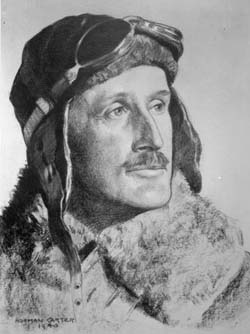
Former Bayview resident Patrick Taylor, ‘Bill’, presents us with a man who grew tall when Australia was becoming a new nation that was strong, independent and with its own unique voice. He embodied all the beliefs of ensuring Australia represented the new world evolving by establishing in his children and through his own attitude to his work the tenets of his pioneer father. Contributing to Nationhood and Community shaped a lifelong path of bravery and staying close to his love of sky and sea.
Born the third son of Patrick Thomson Taylor, a businessman who became chairman of Sydney Ferries Ltd, North Shore Gas Co. Ltd and New South Wales Fresh Food and Ice Co. Ltd, deputy-chairman of the Australian Gas Light Co., and a director of the Newcastle and Hunter River Steamship Co., Norwich Union Fire Insurance Society Ltd and Toohey's Ltd, and was Mayor of Mosman in 1896, Sir Gordon also pursued life with energy.
At 20 years of age he went to England to join the Royal Flying Corps in August of 1916 and flew in the No.66 Squadron. In 1917 he was awarded the Military Cross and promoted to Captain. From then on he flew with the 94 and 88 Squadrons. His brother Kenneth was killed in this war while serving in France. Captain Taylor later wrote 'I deplored the killing and all the other evils of war'. During the second World War he again served, this time with the Royal Australian Air Force, transferring to the Royal Air Force to ferry aircraft from Canada to England.
As a child Sir Taylor so disliked his Christian names that he called himself 'Bill'. In his dinghy, Query, and later in the yacht Triton, he frequented many places in Pittwater throughout his life and competed in Pittwater Regattas. He acquired a lifelong love of the sea which, coupled with his love of flight coalesced to produce a new stage for ‘flying boats’, as it was from Pittwater, too, that he took his first flight in a seaplane, one he himself had converted from a landplane.
On page 70 of ‘The Man Who Saved Smithy’ is one of our favourite passages in this book, recounting this experience in his own words, prefaced by this little notice and picture:
A NEW VEHICLE ON THE ROADS
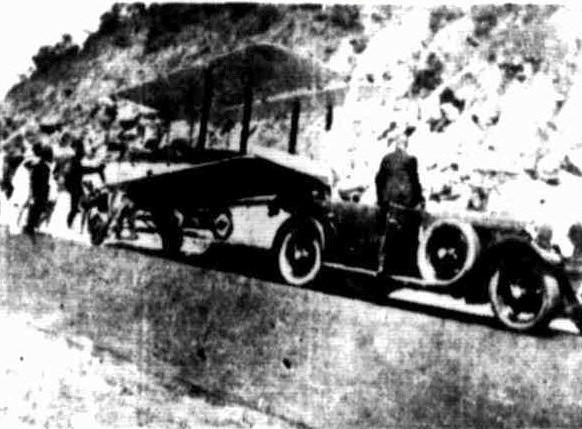
With the increasing popularity of the light aeroplane, this spectacle is likely to be seen more often on the highway: The picture shows Mr. W. Taylor' s plane being towed to Palm Beach after he had landed at Narrabeen, following a flight from Cootamundra. Hitched on to the back of the car, with its wings folded, the plane presented no difficulties in transport. A NEW VEHICLE ON THE ROADS. (1929, January 15).Evening News (Sydney, NSW : 1869 - 1931), p. 1. Retrieved from http://nla.gov.au/nla.news-article115697905
The first few sentences from Page 70:
“ I looked down the bay. It was a morning with a light northerly, one of those early morning breezes that drift off the bay as though the sea were breathing, upon its awakening with the sunrise. There was a straight run of 5 miles, into the wind and with not a boat or any distraction in the way. I looked back at the aeroplane and suddenly made the decision to fly her. This was the moment. I didn’t wait to get clothes and helmet and goggles and all the trimmings. In the freedom of nothing but a pair of shorts I hauled in the light anchor, stowed it in the front seat and, standing in the shallow water, guided the seaplane out into a clear position heading up the wind….”
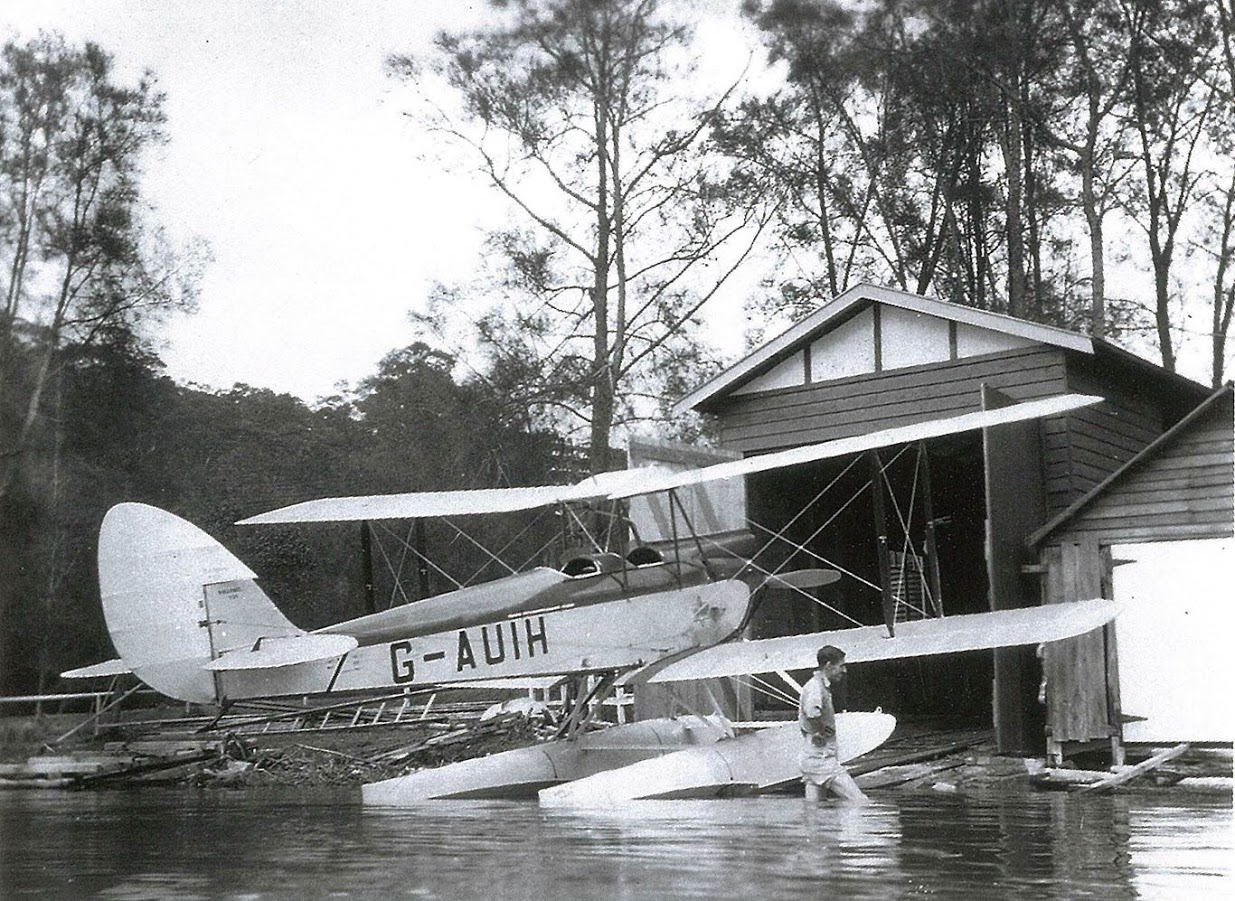
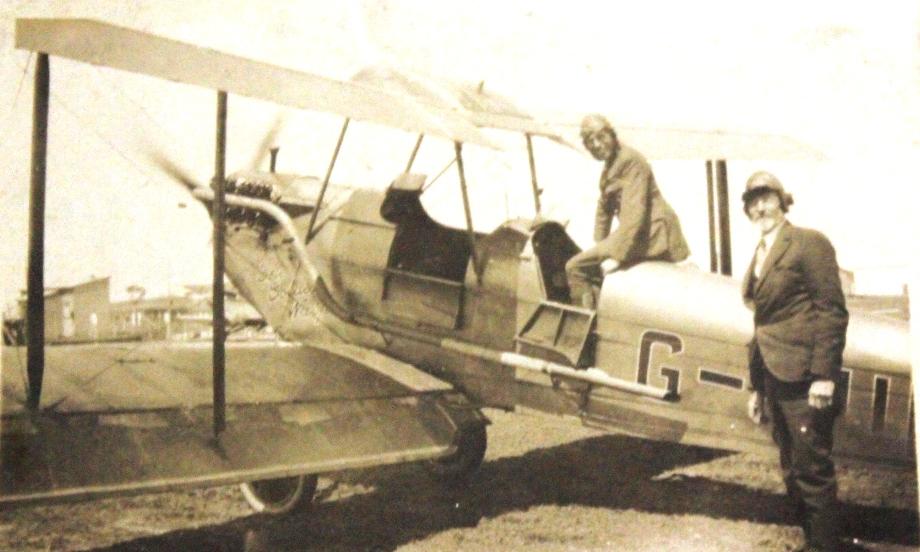
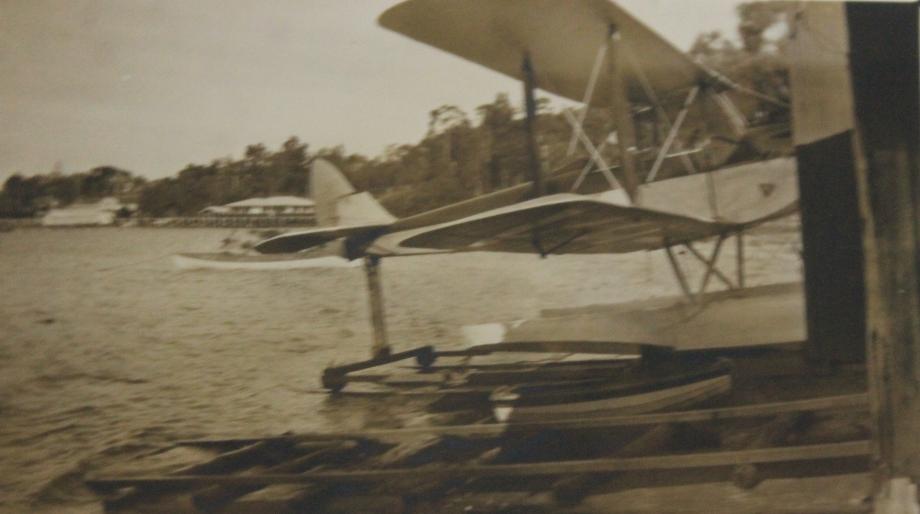
Between wars he flew seaplanes from the harbour, commenced Air Mail between Australia and New Zealand, was chairman of the family firm and also co-pilot with Charles Kingsford-Smith on many trans-Atlantic flights. He wrote and published eight books: Pacific Flight (1935), VH-UXX (1937), Call to the Winds (1939), Forgotten Island (1948), Frigate Bird (1953), The Sky Beyond (Melbourne, 1963), Bird of the Islands (Melbourne, 1964), and Sopwith Scout 7309 (London, 1968).
His love of Pittwater began before his birth when his father purchased land from Robert McIntosh Senior, one of our first local constables, and built a house on the waterfront of Bayview in 1894. Patrick used to sail in his dinghy Query to and from Lion Island, a place that remained dear to his heart. His father similarly fell in love with the area, sailing on Pittwater (where, some sources state, he once owned Scotland Island) and farming at Hartley were his main recreations. Bayview was farm lands outside of the few holiday homes then, oyster leases thrived at Church Point.
Don Taylor, son of Don Taylor, a son of P T Taylor, explains:
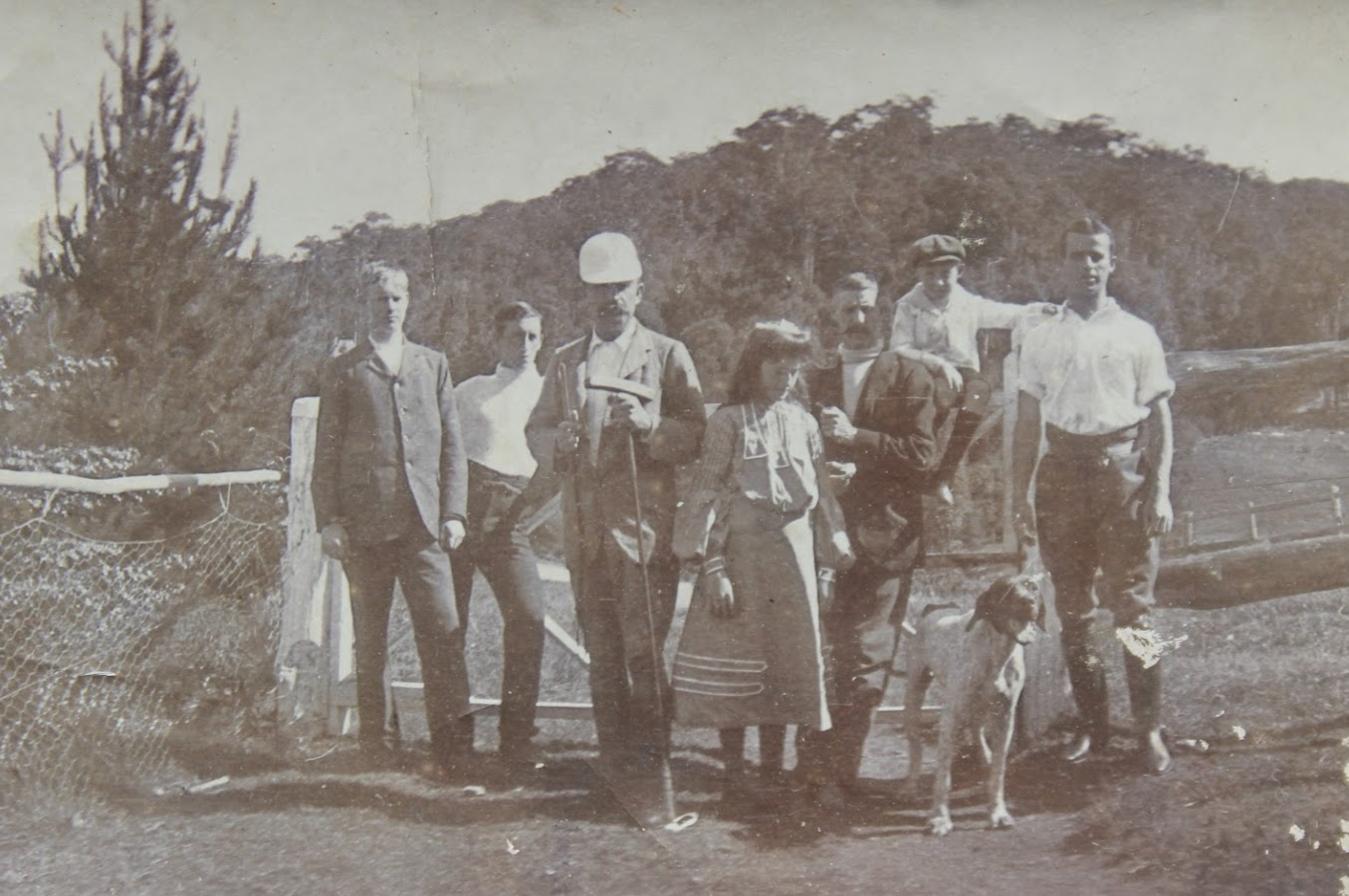
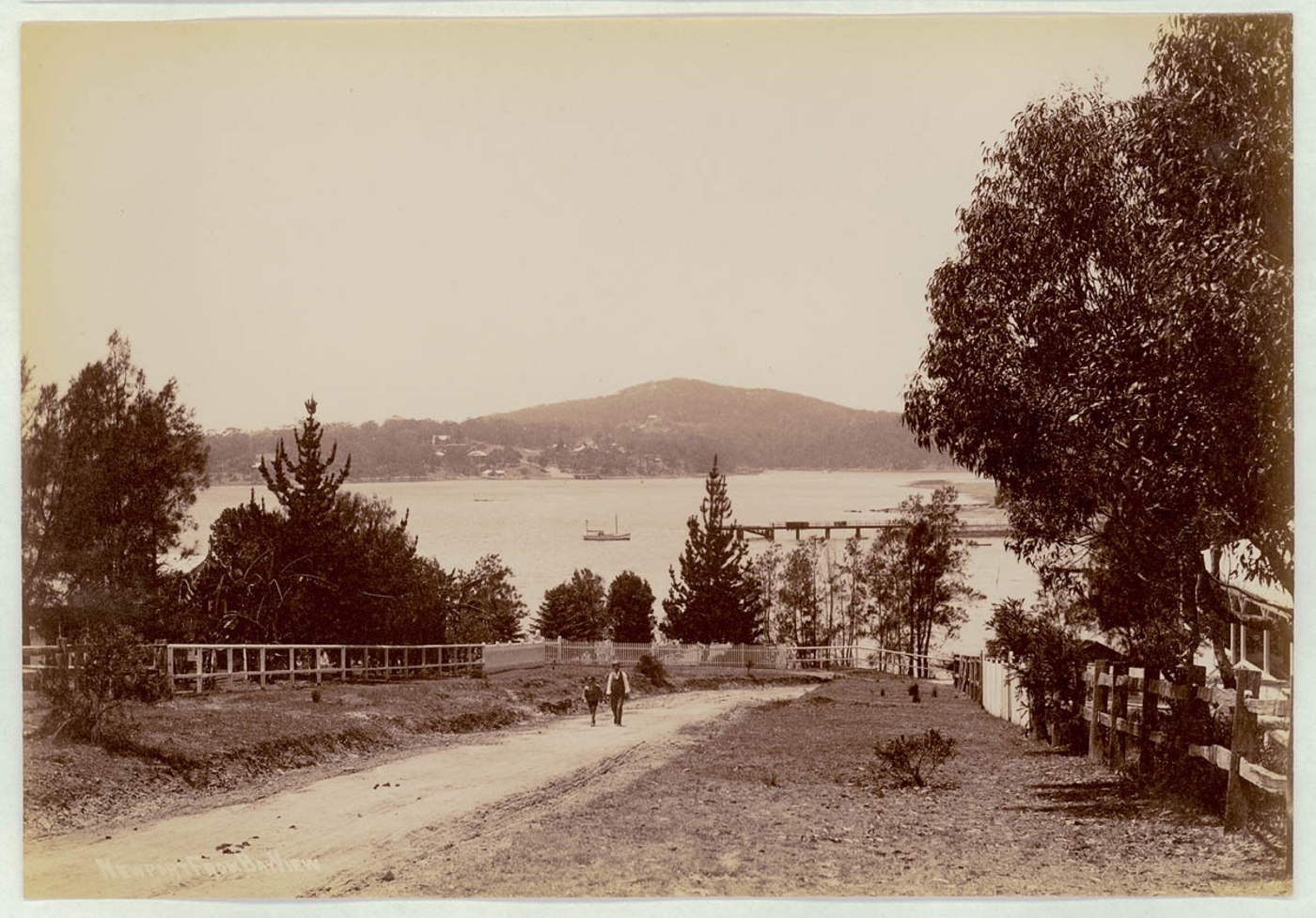
Above: 'Newport from Bayview', ca. 1900-1910, Image No.: a116491, courtesy State Library of NSW.
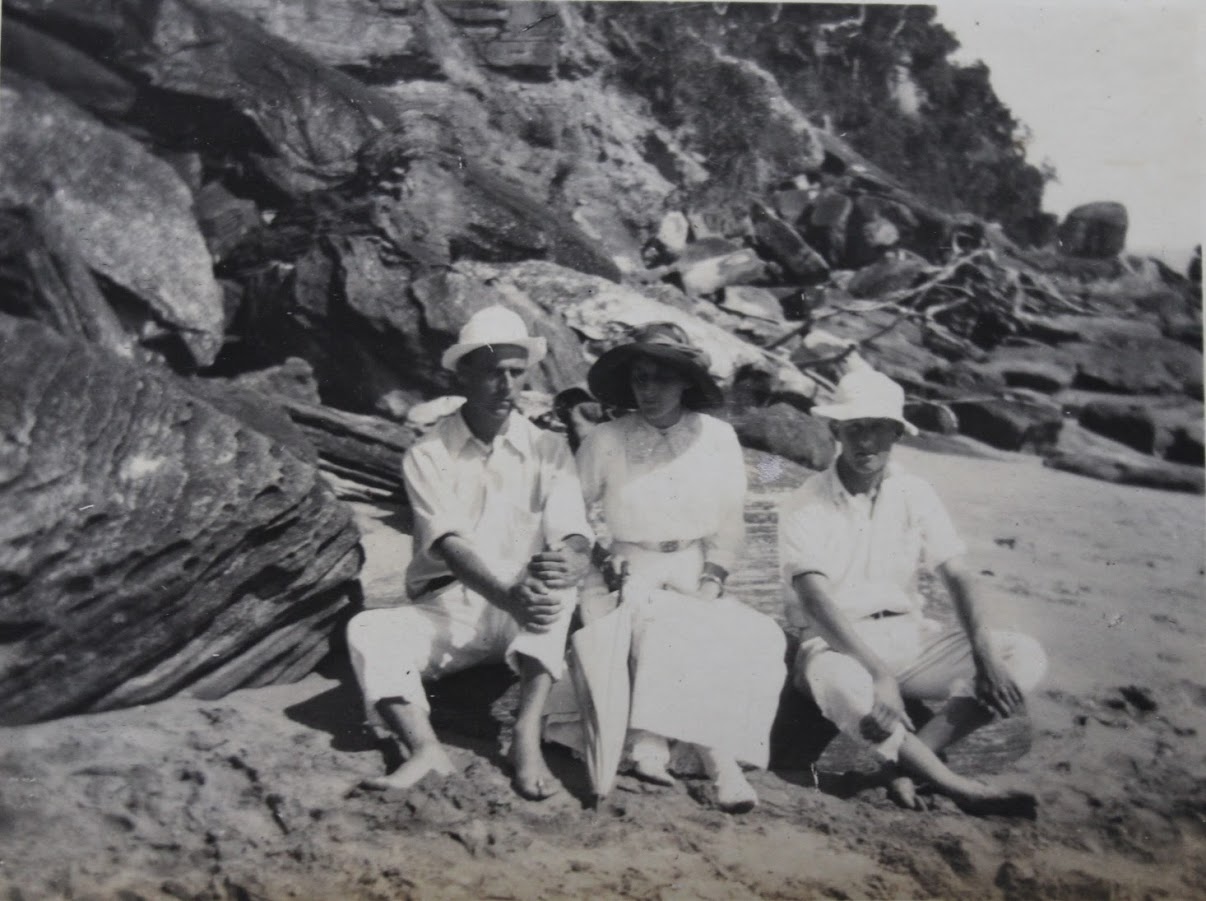
Airman Started A New Kind Of School
In a little bush clearing overlooking the reaches of Pittwater, 60 children are going to Australia's most unusual school-founded by an airman. Captain Patrick Gordon Taylor, pioneer of world air routes, set out after the war to blaze a new trail-and it led to Loquat Valley School, Bayview. He came home from service on the North Atlantic air routes with two daughters, Jennie (now 9) and Sue (7), and found there was no school for them to go to up that way. Others in neighbouring districts were full.
Captain Taylor decided to found his own school and neighbours welcomed the idea.
Captain Taylor arranged to start in a tennis club building, but the club found it needed its building. So 13 children attended their first session on the verandah of a nearby home.
From the old Army camp in French's Forest Captain Taylor bought two big huts.
Captain Taylor got the bricks by driving around the country in his car, telling his story to sympathetic but unhelpful brick-yard men. At last, one said: "You shall have the bricks to-morrow."
He got the bricklayer by persuading his household maid to talk her boy friend, a brick-layer on another job, into it.
Captain Taylor and his wife, his secretary and his school staff sawed wood, painted walls, made window boxes, helped with the building-and got the school going.
Now there are two full-time teachers at the school-Miss Joyce Kennington, who started the school in 1946 With Mrs. Gomme, and Mrs. John Day, who teaches the older children.
Right from the start Captain Taylor determined it should be an Australian school for young Australians to give them a feeling of confidence in their country and themselves, and to break away from ideas unsuitable to life in Australia.
He poured more than £5,000 into his ideal.
Children aged 3 to 11 sit at desks built of Australian wood, in airy classrooms with walls tinted in warm shades and ceil-ings a pastel blue.
BUSH RAMBLES
The children see their lessons chalked on a green board-not black, because it is too drab-1 and on their bush rambles they learn nature lore from seeing koalas and wallabies and possums and jet black rabbits frolicking in the undergrowth.
They swim in Pittwater, they ride ponies, they learn ballet.
Captain Taylor watches the school grow and plans how he will extend it-a swimming pool here, a new building there. And because it is an ideal he is working for, he puts back into it all the profits from fees.
BELOW: Children leave Loquat Valley School, Bayview, after their day's lessons. Airman Started A New Kind Of School (1949, November 20). The Sunday Herald (Sydney, NSW : 1949 - 1953), , p. 6. Retrieved from http://nla.gov.au/nla.news-article28665905
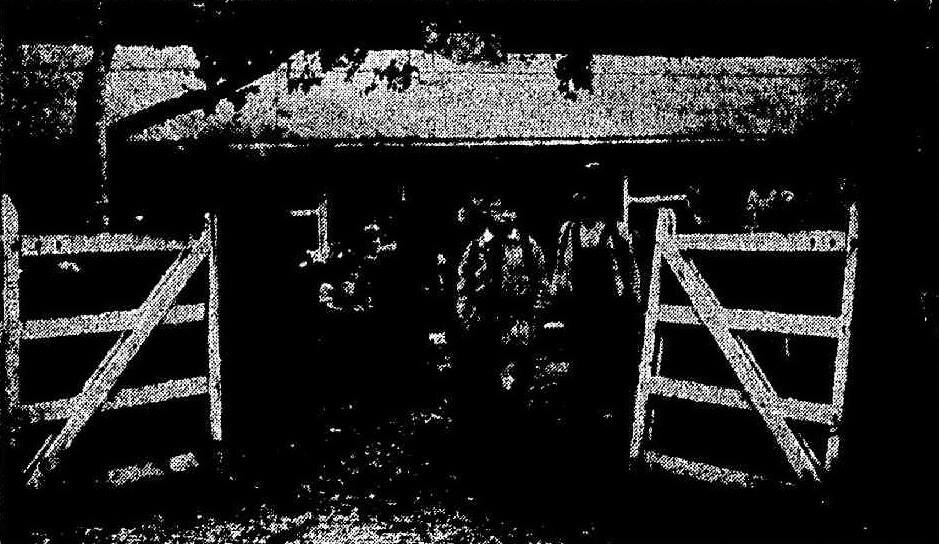
Further Reading:
Sir Taylor’s Frigate Bird II at Powerhouse Museum. See at: http://www.powerhousemuseum.com/collection/blog/index.php/tag/frigate-bird-ii/
Biography: http://www.adb.online.anu.edu.au/biogs/A120204b.htm
The Man Who Saved Smithy - Fighter pilot, pioneer aviator, hero: the life of Sir Gordon Taylor MC, GC by Rick Searle - a few insights from the biographer of this new Allen&Unwin book on a local hero
Loquat Valley School:
Drawing on the philosophy of its founder, aviator Sir Gordon Taylor, Loquat Valley School embraces the spirit of endeavour and challenge. Sir Gordon, who flew with Charles Kingsford-Smith, founded the School in 1947 and named it Loquat Valley after the fruit grown locally by the early settlers. He wrote, "Loquat Valley School is a name with meaning, linking the tradition of early Australian pioneers with the life of the children today and with the future."
Having served in the Second World War ferrying aircraft from North America to England, Captain Taylor, with his wife Joan and his daughters Jennie and Sue, made Bayview their home. Taylor dreamed of a school where the children would learn about all the peoples of the world, their cultures and history. He hoped to take them beyond the limited education he had experienced when he was young. Sir Gordon wanted children to have a great love for and pride in their country and he dreamed of a world where social and economic barriers did not exist. He wanted a school in which all the children would hold out their hands to one another when help was needed. From: http://www.loquatvalley.nsw.edu.au/default.php?id=7
LOQUAT VALLEY ANGLICAN PREPARATORY SCHOOL
Mr BROGDEN (Pittwater): It is with great pleasure that I speak today to celebrate the golden jubilee of Loquat Valley Anglican Preparatory School, Bayview. In 1947 Gordon Taylor, later Sir Gordon, founded Ballanger Grange, which was renamed Loquat Valley two years later. It is worthwhile noting the extraordinary life of Gordon Taylor, the founder of Loquat Valley. A pioneer Australian aviator, Sir Gordon Taylor was born in 1896 and educated at The Armidale School. After two years service with the Australian Imperial Force he was granted leave in 1916 to join the Royal Flying Corps in England. He was awarded the Military Cross in 1917.
After the war Sir Gordon Taylor worked for a time with the de Havilland aviation company, returning to Australia in the mid-1920s. He was hired by Charles Ulm as a pilot on the first Australian National Airways routes to Brisbane and Melbourne. In 1933 and 1934 he flew with Charles Kingsford Smith. In 1939 Taylor made the first Australia-West Africa flight across the Indian Ocean on behalf of the British and Australian governments to survey possible flying boat bases for wartime use. During World War II he served with the Royal Air Force and was a member of the RAF transport command. In 1951 Taylor surveyed a proposed Pacific commercial aviation route between Chile and Australia. He was knighted for services to aviation in 1954 and died in 1966.
During this distinguished career Sir Gordon Taylor also found time to start a school and pursue his vision for broad, limitless education for young Australians. Using his own land just metres from the foreshore of beautiful Pittwater, Sir Gordon built a school whose aims today are to provide an educational environment which allows each child to develop social skills, spiritual growth, academic and artistic competence, emotional stability, and positive physical attitudes. The children are guided in the development of sound self-esteem, a sense of responsibility, self-discipline and respect for others based on Christian principles. Today the school is hidden away amongst loquat trees in Bayview. Its modest buildings and oval are part of the landscape and the school is an important - and now essential - part of the Pittwater community.
From: www.parliament.nsw.gov.au/prod/parlment/hansart.nsf/V3Key/LA19970422030

Above (far right) : P G Taylor's father P T Taylor on balcony of La Corniche, Mona Vale (where blocks of units are now) in 1911. Picture a3289053h from the Allen Family Album, image courtesy Mitchell Library, State Library of NSW.

Above: 'Newport From Bayview' circa 1900-1910,courtesy State Library of NSW. Below: Taylor and Kingsford-Smith.

The Women Who Wait at Home - Husbands Pioneering Air and Desert
BY A REPRESENTATIVE OF THE WOMEN'S SUPPLEMENT
TWO pioneering expeditions of Australian and world interest are in 'progress at the same time The flying-boat Guba is investigating the possibilities of air routes across the treacherous Indian Ocean. Totally different in character, but also important in its possibilities, and with no less a share of danger is the Simpson Desert Expedition. One man in each of those expeditions has left a wife behind him in Sydney. Both have to wait two months before their husbands return. Here is the story of how Mrs. P. G. Taylor, wife of the leader of the Guba flight survey, and Mrs. H. O. Fletcher, wife of the biologist of the Simpson expedition, are facing up to that two months strain.
 MRS. P. G. TAYLOR,' wife of the leader of the Guba Indian Ocean flight expedition, has a flat at Vaucluse. For our talk I caught up with her at the Australia Hotel as she was on her way to dine with Captain Taylor's mother, Mrs. P. T. Taylor. That dinner between the two women who are most affected by the absence of Captain Taylor on this adventurous work, contained more admission of their common desire for a protection against anxiety than either of them were likely to admit in conversation. The point is that both women have a huge respect. Mrs. P. G. Taylor gives one a direct impression of this strength. She is cheery and direct in style, and even outspoken enough to admit to some of her anxiety, but is more concerned with keeping up an interest in normal living to kill anxiety.
MRS. P. G. TAYLOR,' wife of the leader of the Guba Indian Ocean flight expedition, has a flat at Vaucluse. For our talk I caught up with her at the Australia Hotel as she was on her way to dine with Captain Taylor's mother, Mrs. P. T. Taylor. That dinner between the two women who are most affected by the absence of Captain Taylor on this adventurous work, contained more admission of their common desire for a protection against anxiety than either of them were likely to admit in conversation. The point is that both women have a huge respect. Mrs. P. G. Taylor gives one a direct impression of this strength. She is cheery and direct in style, and even outspoken enough to admit to some of her anxiety, but is more concerned with keeping up an interest in normal living to kill anxiety.
"How are you going to face the strain of the seven weeks the whole flight will be spread over. " Mrs. Taylor? Are you not anxious about your husband?" I asked.
"Well, I have had my anxious moments already, but they are over now. I share my husband's confidence In himself and the fine men who are with him. '.What surprised me most was that every- one seemed to think of the women who were left behind, and Captain Taylor's mother and I were simply deluged, with messages from people who were in contact with the progress of the flight. I was all arrayed for an afternoon skating session, when we first heard that the Guba had failed to make Cocos. Skating was off then, and we settled into a vigil of waiting. There were definite sighs of relief when between five and six we heard that the plane had made Batavia. "I was really not so troubled over this episode as I was while I waited for news of their arrival at Port Hedland. The Guba is a flying-boat, and the hop was entirely across country."
"I suppose you took a restful sleep after all that?" I suggested.
"Not a bit of it. I kept a dinner appointment, and went off to it immediately."
Mrs Taylor has worked out a sensible plan to combat this long wait on the return of her husband. She will visit friends and relatives in the country, and left last Thursday for Young on the first lap of her holiday.
Strong Interest in Aviation
AFTER a short stay at Young, Mrs. Taylor will stay with her sister, Mrs. Lance Lanagan, near the northern border of New South Wales. Their home is in Yugilbar, at Warialda. The only thing that Mrs. Taylor believes she will miss of city life is the opportunity for ice-skating. "I have not been skating" long, but it is a confirmed passion," she says; She took time off for skating right up till the day before her departure for the country.
She has strong interest in aviation, likes flying, but flying does not like her, as the saying goes. "I never seem to get over air-sickness," she complained, "although I have often responded to my husband's keenness to have me come up in his private plane. Perhaps I'll" get used to it if I stick at it. I am treated to talks on navigation, .and like it, when my husband points -out, the guiding stars in flight navigation. It makes astronomy seem a tempting subject. At least, it is useful in taking the edge off personal vanities. Those stars are set in such enormous distances and man seems so small against, it all."
But there is one exhilarating interest which Captain and Mrs. Taylor share in common-yachting. The 33ft Christina, which rocks at anchor in the Pittwater, Is their own yacht, and they spend most week-ends sailing her about. Mrs Taylor shares the work of manning the vessel, and can do it by herself.
"Still," added this rather modest woman, "there is nothing wonderful in that, as a big yacht is easier to manage than a small one." Last trip together aboard the Christina was the very weekend before the departure of the Guba.
Mrs. P. T. Taylor, of Kirribilli, mother of Captain Taylor, is small and silver-haired. The numerous telegrams and messages of the last few days seemed to have "conditioned" her, as she immediately said, "Well, what's the news? Good, I hope?" she said. "We were really anxious when the flying-boat missed Cocos. I seem to have been less steady about this one than others. I have always been so used to my son's flights, ever since the war days, when he threw in his proposal to become a doctor, and I went home with him, where he took up flying. Even the famous Tasman flight with Kingsford Smith scarcely perturbed me'. It seems automatic now to believe that they will get through."
The Women Who Wait at Home. (1939, June 12). The Sydney Morning Herald (NSW : 1842 - 1954), p. 8 Supplement: Women's Supplement. Retrieved from http://nla.gov.au/nla.news-article17613808
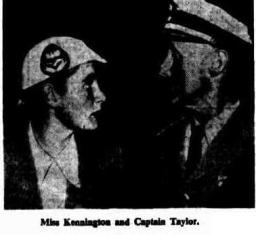 Captain Taylor Flies Back-With A Fiancée ; Captain P. G. Taylor, completing the last leg of his return survey flight from Chile, landed at Brisbane yesterday evening-with, a fiancée. He announced the engagement at a reception at the British Consulate at Papeete, Tahiti, before taking off for the final hop to Brisbane.
Captain Taylor Flies Back-With A Fiancée ; Captain P. G. Taylor, completing the last leg of his return survey flight from Chile, landed at Brisbane yesterday evening-with, a fiancée. He announced the engagement at a reception at the British Consulate at Papeete, Tahiti, before taking off for the final hop to Brisbane.
The fiancée is Miss Joyce Kennington, who had acted as Captain Taylor's agent for the most important stages of the South Pacific survey flight from Tahiti to Chile. Miss Kennington joined the survey plane Frigate Bird II at Papeete for the return flight. Miss Kennington, 22 years old and a schoolteacher, is the daughter of Mr. and Mrs. J. Kennington, of Prince's High-way, Arncliffe. She helped Captain Taylor in starting a primary school near his home at Pittwater. She later taught full-time at the school, which was attended by about 60 pupils, including Captain Taylor's two daughters by an earlier marriage. Captain Taylor is 54. His first wife died just before Christmas last year.
Frigate Bird II will leave Brisbane this morning and is expected to touch down on Sydney Harbour about 3 p.m. to-day. Rose Bay Flying Base will be open to the public this afternoon. The Minister for Civil Aviation, Mr. T. W. White, last night appealed to the people of Sydney to "turn out and give Captain Taylor a worthy welcome."
Captain Taylor Flies Back—With A Fiancee. (1951, April 21).The Sydney Morning Herald (NSW : 1842 - 1954), p. 1. Retrieved from http://nla.gov.au/nla.news-article18209420

|
Capt.PGTAylorRemarries1951.pdf Size : 314.381 Kb Type : pdf |

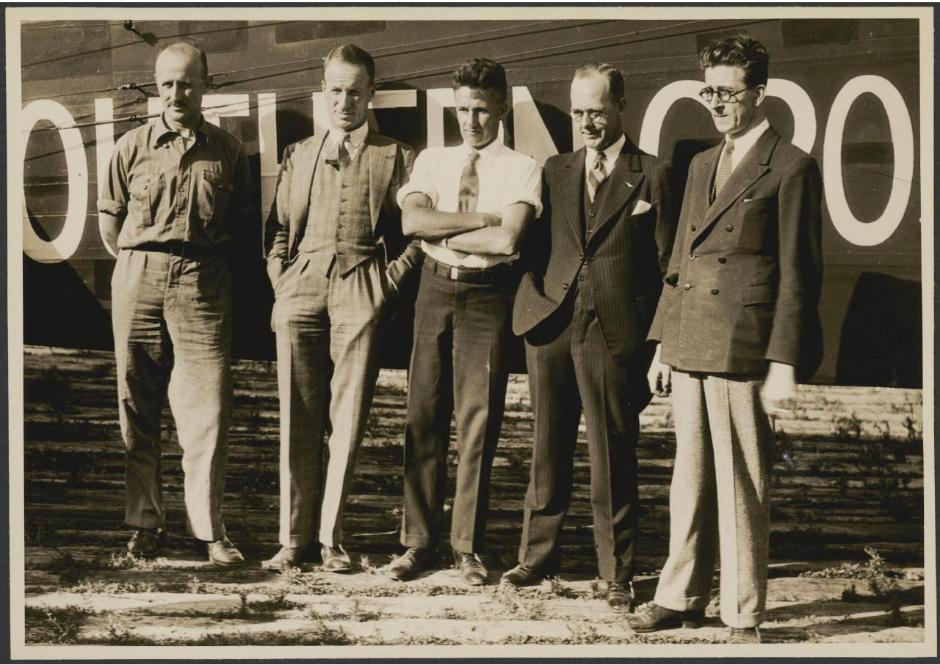
Left to right, P.G. Taylor, Smithy [i.e. Charles Kingsford Smith], John Stannage, Stan Nielson and Jack Percival, before Australia-New Zealand flight to Gerringong, Mascot Aerodrome, 1933 [picture] / Sydney Morning Herald and Sydney Mail, Sydney 1933. Photo courtesy National Library of Australia, Image No.: PIC/3394/938
Also available:
Sir P G Taylor - threads collected and collated by A J Guesdon, 2011